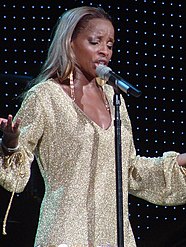|
Hip-hop soul
Hip hop soul is a subgenre of contemporary R&B music, most popular during the early and mid 1990s,[1] which fuses R&B or soul singing with hip hop musical production.[1] The subgenre had evolved from a previous R&B subgenre, new jack swing,[2] which had incorporated hip-hop influences into R&B music.[2] By contrast, hip hop soul is, as described in The Encyclopedia of African American Music, "quite literally soul singing over hip hop grooves".[1] The genre was most popular during the mid and late 1990s[1] with artists such as Mary J. Blige (known as the "Queen of Hip-Hop Soul"), Jodeci, Faith Evans, TLC, and R. Kelly.[2] By the late 1990s, hip hop soul would lead to the creation of neo soul,[1][2] which retained the hip hop and R&B influences while also adding elements of classic 1970s soul music.[1] DescriptionHip hop soul evolved directly from new jack swing, a form of contemporary R&B popularized by artists and producers such as Teddy Riley and his group Guy, Keith Sweat, and Bobby Brown.[1][3] New jack swing had incorporated elements of hip-hop music—primarily hip-hop-inspired drum tracks and rapped verses[1]—into contemporary R&B music also heavily inspired by the work of Prince.[3] Hip hop soul shifted from new jack swing's reliance on synth-heavy production and took the hip-hop/R&B synthesis further by having R&B singers sing directly over the types of sample-heavy backing tracks typically found in contemporary hip-hop recordings like boom bap.[1][3] The creation and evolution of hip hop soul led to an increasingly symbiotic relationship between its parent genres.[4][5] Hip hop soul acts presented themselves in styles and personas comparable to those of rappers[3][6]—dressing in hip hop fashions and adopting a tougher image than the traditional pop-friendly personas of R&B artists[3][6] (the existence and popularity of hip hop soul also had the opposite effect on mainstream rappers, who took on some of the elements of the R&B artists' personas to become more palatable to mainstream audiences).[5] The subgenre increased the popularity of R&B music among the younger hip-hop audience, leading to better sales and airplay success for hip hop soul recordings versus previous forms of post-disco R&B, on the Billboard pop music sales charts.[7] It also increased the popularity of hip-hop music and culture with older audiences and corporations looking to market urban music.[8] However, the creation of hip hop soul has been argued by music journalists and fans of R&B music to have "killed off" traditional styles of R&B.[5] History The term "hip hop soul" is attributed to record producer and later rapper Sean "Puffy" Combs,[8] who came up with the term during the promotion of What's the 411?, the 1992 debut album of Uptown Records artist Mary J. Blige.[8] Blige was promoted by the company as the "Queen of Hip-Hop Soul", and her debut album, primarily produced by Combs, was filled with mid-tempo R&B ballads sung over hip-hop beats and samples.[8] Similarly, Diary of a Mad Band (1993), the second album from another Uptown act, Jodeci, featured the four-man male vocal group moving away from its new jack swing origins into hip hop soul recordings driven more by hip-hop rhythms than melodies.[3] A large number of male acts, both solo performers and groups, followed or competed with Jodeci, among them R. Kelly, 112, Tony! Toni! Toné![7] and Blackstreet, a second group formed by Teddy Riley.[3] Hip hop soul artist Montell Jordan was the first R&B singer signed to hip-hop record label Def Jam Recordings;[6] his 1995 single "This Is How We Do It", built around a sample of Slick Rick's 1989 hip-hop song "Children's Story",[4] typified the sound of the subgenre. Another key recording is "I'll Be There for You/You're All I Need to Get By", a 1995 duet between Wu-Tang rapper Method Man and Mary J. Blige which interpolated Method Man's rapped verses with Blige singing a cover of Marvin Gaye and Tammi Terrell's "You're All I Need to Get By".[11] "I'll Be There For You/You're All I Need to Get By" won the 1996 Grammy Award for Best Rap Performance by a Duo or Group.[3] The female vocal group TLC, consisting of two singers and a rapper, had their start in new jack swing (dubbed "new jill swing" in their case)[3] with their debut album, Ooooooohhh... On the TLC Tip (1992). Their second album, CrazySexyCool, to which Puffy Combs was a significant contributor, moved the group into the aesthetic of hip hop soul.[3][6] Similar female acts of the time included SWV, Adina Howard,[6] Faith Evans, and Total, the latter two acts signed to Puffy Combs' own label, Bad Boy Entertainment.[3] Hip hop soul as a distinct subgenre experienced a lull in popularity with the spread of hip-hop influences into more standard R&B music by the end of the 1990s[12] and the emergence of neo soul, an R&B subgenre which blended hip-hop and contemporary R&B with heavier influences from the soul music of the 1960s and 1970s.[1] Examples of neo soul artists include Tony! Toni! Toné!, D'Angelo, Erykah Badu, and Lauryn Hill.[3] Several newer artists continued to perform in the hip hop soul subgenre in its original form from the 2000s forward, among them John Legend, Anthony Hamilton, and Keyshia Cole.[1] See alsoReferences
|
||||||||